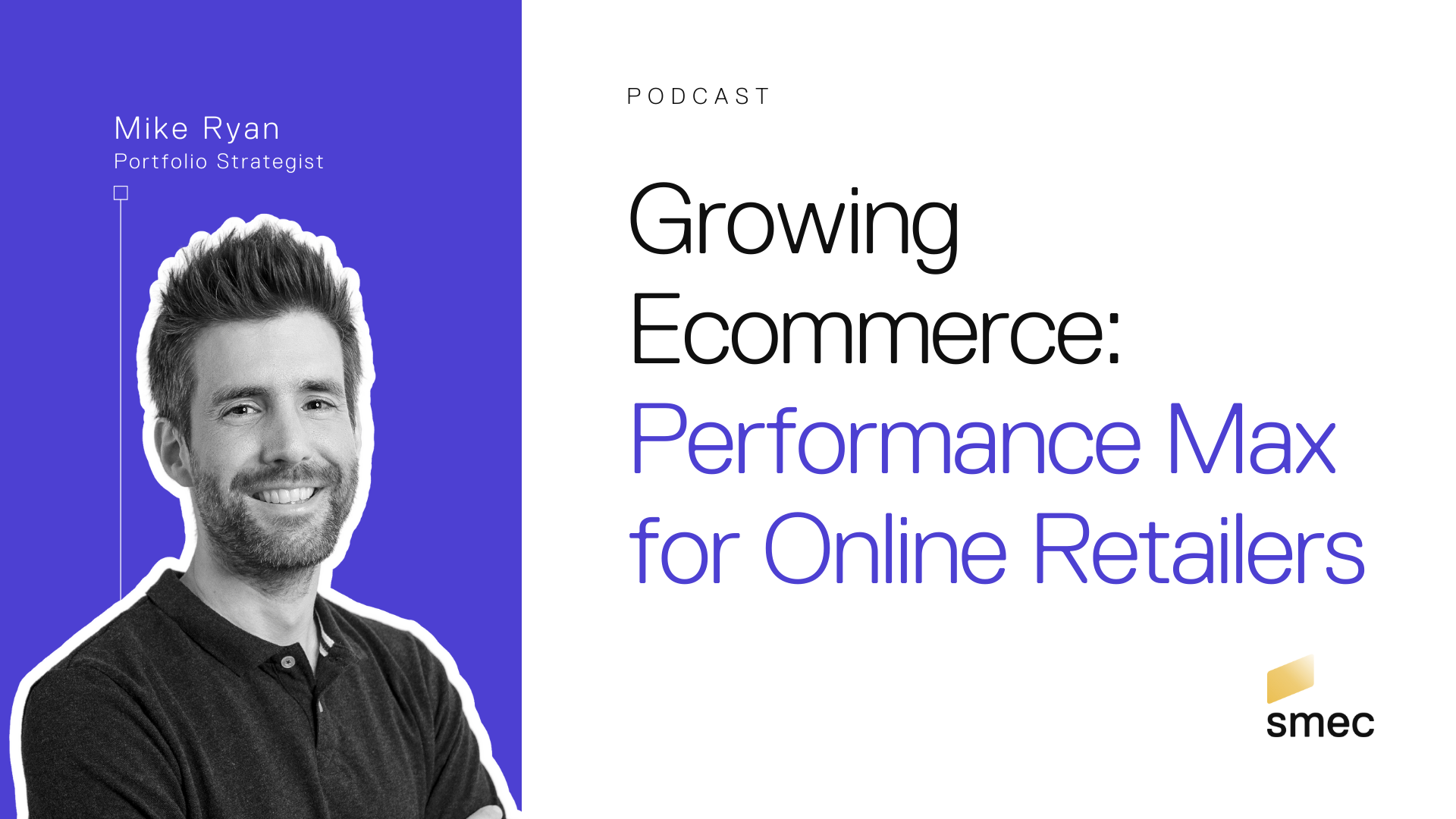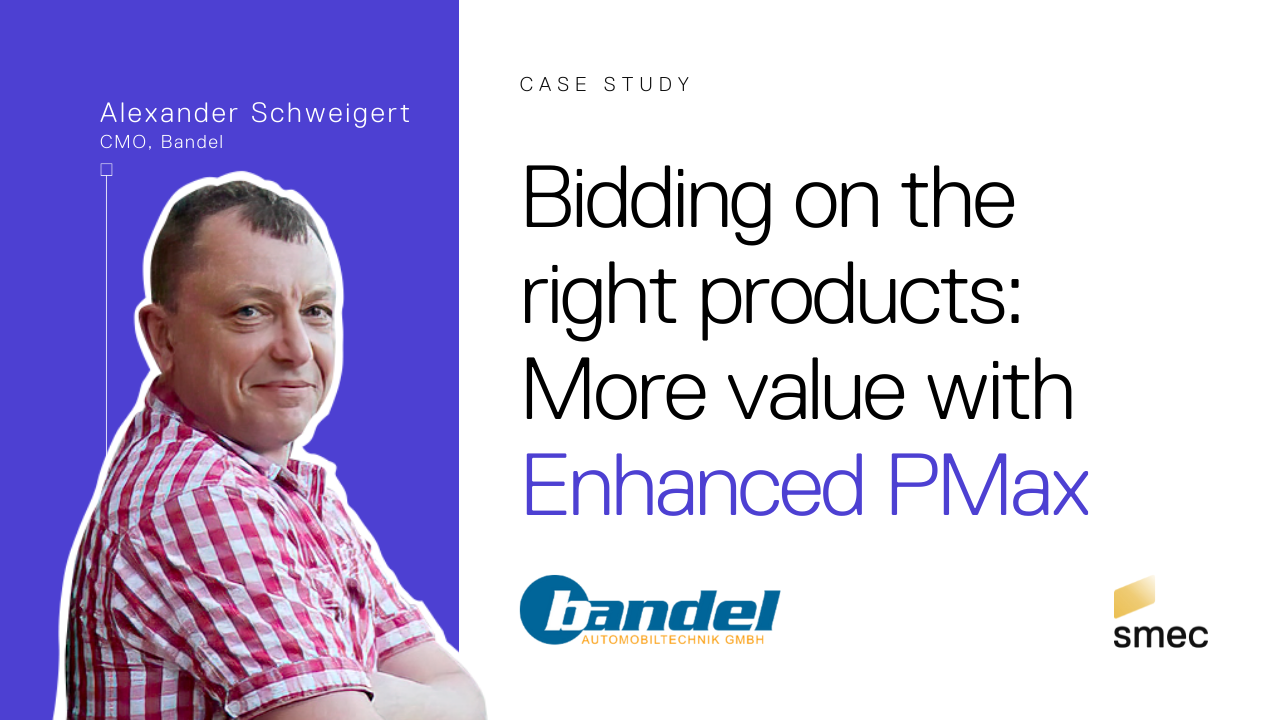Subscribe to join thousands of other ecommerce experts

For online retailers using Google Ads, Performance Max is a real black box that represents a new obstacle in the digital advertising world. And, even though Google provided some resources on the new campaign type, there are still many open questions. Today, I will try to shed light on those urgently asked questions regarding PMax.
Some of the questions you will find below have been asked by participants of our Performance Max webinars in July. Did you miss the webinar? Here’s your chance to rewatch it: We have the recording available on our website.
Table of Contents
About Performance Max
What is Performance Max and what impact will it have on my existing retail campaigns?
As we already described in this article, Performance Max is a new goal-based campaign type that allows retailers to promote their products across the entire Google network by using one single campaign. This means that you will only need one campaign to run ads on Search, Display, YouTube, GMail, Discover and Maps. At the center of Performance Max campaigns are asset groups that contain all necessary information to provide your ads across these multiple channels, such as images, logo, videos, promotional text, links and more – so no more ad and product groups. Google’s technology uses all the assets you provide to test out different combinations and identifies which works best to achieve your goal. This allows you to reach a far broader audience.
The downside: This highly automated campaign type provides only limited reporting capabilities, making it a black box for many advertisers. To overcome these limitations, we recommend using a segmented campaign structuring approach.
If you have been running Smart Shopping and/or Local campaigns, please note that these campaigns will automatically be upgraded to Performance Max in September 2022. This will most likely require you to rethink your Shopping campaign strategy. As for Standard Shopping campaigns, Google announced that this campaign type will remain available for the time being.
If you want to learn more about the specifics of Performance Max for retailers – I dedicated an entire episode of the Growing Ecommerce podcast to the topic:

How to structure Performance Max campaigns
What is an ideal structure for PMax campaigns? Does the previous best practice of different product groups still work?
To offer a general answer: your first priority in structuring your Performance Max retail campaigns is to identify key themes. That’s because asset groups are at the center of PMax. And assets need a common thread in order to build coherent, relevant creatives. For many advertisers, this could mean brands, categories, collections, etc. Product groups have now become listing groups, and this can be a great way to serve further data to Google. The asset group cares for the thematic relevance, while a combination of campaign and listing group can care for other topics such as inventory characteristics (product lifecycle, stock level & depth, sell-through rate, etc). But the days of ultra-granular campaigns are over. You need to focus on identifying segments of meaningful size and meaningful difference (heterogeneity).
How can I best monitor price competitiveness to use it as a custom label, as part of PMax campaign structure?
The simplest way to do this is using Google’s benchmark data, which is available in the Merchant Center, in the Ads UI, or best case via the Merchant Center Transfer for BigQuery. However, if you’re looking for more comprehensive data (better assortment coverage, more channels) and/or more detailed data (specific competitors), then I would advise a third-party solution. We can help you with both options by the way.
Note: GTIN is generally a prerequisite for price monitoring.
Tips for running Performance Max campaigns
Can I run Performance Max alongside Shopping? If so, should I run it with the same structure?
While Performance Max is intended to be complementary to most campaign types, Shopping is not one of them. You need to carefully think through the logic of running PMax and Shopping in parallel in order to avoid killing the Shopping traffic. That said, there could be interesting use cases for standard Shopping campaigns in parallel. For example, bringing traffic to products that PMax appears to neglect.
Via Google Ads editor it’s possible to opt-out of Search network, Search partner network and Display network. Would you recommend considering this?
Opting out of these networks would allow separating the worlds of Search and Shopping. It is indeed possible to create PMax retail campaigns that exclude certain assets and placements, and lots of debate about use cases and value. For some business models or verticals, it can make sense – let’s say you are in a sensitive or highly regulated category. Or, you might just be dissatisfied with the previous performance of that kind of inventory, and you don’t want to give it another shot. Fair enough. Currently, it’s my recommendation to try out PMax “as intended” to establish a baseline, and then you can get an understanding of volume or efficiency tradeoffs.
In terms of new customer acquisition – How do you prevent branded search terms through PMax?
We heard that some Google Ads users are seeing excellent ROAS however the majority of sales are from branded terms. This is a widely-observed and quite controversial phenomenon in PMax right now.
So why does volume from branded campaigns drop when performance max launches? 🤔
— Collin Slattery (@CJSlattery) June 14, 2022
It seems that this brand cannibalisation behavior should genuinely not occur. The recommendation is to apply brand negatives to exclude this traffic and then cover branded traffic with dedicated standard campaigns. However, this is more complex than it ought to be. Read here for an excellent summary from Greg Finn / Search Engine Land.
How do I turn off mobile app placements in Performance Max?
Many feel that mobile app placements are spammy, so it’s quite popular to turn off that traffic. In the Ads UI, go to Placements → Exclusions. There you can exclude apps at the account level in order to prevent PMax from serving there.
See how we take back control of Performance Max campaigns
Read nowReporting issues with Performance Max
Why does PMax offer such low transparency into results i.e. there are much fewer results metrics available?
For better or worse, this has been a key part of Google’s product strategy. There are different dimensions to this. One reason: Google wants to limit constraints on the bidding environment that might restrict or disturb their machine learning. This explains the move toward more consolidated campaigns and fewer promotional and placement controls. Google would rather have advertisers focus on guiding the algorithm with strong start signals and strong goal signals while letting the machine handle most things in between.
Having said all that, if Google would offer more insights into Performance Max, many of them would not be directly actionable and/or might conflict with human judgment. This could agitate advertisers, so Google has purposely removed or limited insights (which also agitates advertisers!). Many Google Product Managers have spoken openly about limiting insights, so it is semi-official information, not a conspiracy theory. Meanwhile, Google team members like Ginny Marvin and Rodney Ip suggest that Google has heard advertiser complaints about reduced insight and transparency, and they do intend to add more insights to Google Ads and the Google Merchant Center. However, it’s up to Google to decide which exact insights are offered.
Google does not provide segmented data. Will data-based decisions in regards to evaluating performance and optimising on that basis be possible?
Sadly it’s true that there is currently no reporting available at the asset group level. Placement reporting is also of limited utility right now. We can only hope that Google will expand the current reporting options. However, many other reporting dimensions are available, including campaign and item ID (which had previously been missing). I wouldn’t say it’s impossible to report PMax campaigns and make data-based decisions.
First results we got
Are you already experiencing better results on Performance Max than you’ve had with Smart Shopping?
We see good results from Performance Max for ecommerce but it’s not as simple as waving a wand: for example, we have seen cases where PMax had high initial efficiency (ROAS) when testing, but struggled to scale. But also, we have seen cases that just work. I cannot claim to verify Google’s 12% uplift number. Disclaimer: early migrations were occurring on a manual basis before the 1-click tool had been released. An advantage of the tool is that PMax does not cold start but rather builds directly/continuously on the data generated by Smart Shopping. We like what we’re seeing and we are recommending the tool. A big plus of Performance Max for retailers is that you can produce more advanced strategies than in SSC, so if you’re looking beyond ROAS at real business metrics, you might like it.
Let’s give you a hands-on example: Together with our client Bandel we implemented our Enhanced Performance Max approach. First step: analysing their current Smart Shopping setup. Based on this we segmented their campaigns for PMax, factored in business data and added automation to the equation. To test the setup we conducted a 30-day campaign split test resulting in a clear uplift in the value/click across all campaigns. But see for yourself:

How does Performance Max compare to Standard Shopping campaigns?
Regarding standard Shopping, there is no valid apples-to-apples way to compare it with Performance Max. I know that’s frustrating, but they are simply different. This is a bit of a hot take maybe, but Standard Shopping wasn’t broken, and it still isn’t. Based on current forecasts, it looks like 20% of advertisers (1 in 5) will not adopt PMax. And that’s fine – there could be reasons related to the business model or marketing strategy, which prohibit usage of Performance Max for retailers. As you might know, I’ve been quite critical of technology like this in the past, but I do encourage people to be open-minded and test Performance Max. Whether we like it or not, it’s the future of Google Ads. If you’re dissatisfied, you don’t have to continue using it.
Final recommendation
Does Performance Max still feel like a black box to you? Then it’s time to check out our Enhanced Performance Max approach. We have developed an efficient data-driven and automation-based solution to help you make the most of the new campaign type and beat the competition.
Get in touch with us to learn more about Enhanced Performance Max and how to get started!

